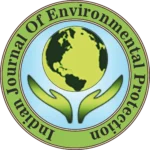IJEP 41(6): 621-626 : Vol. 41 Issue. 6 (June 2021)
Shri Krishna Singh and A. R. Quaff*
National Institute of Technology, Department of Civil Engineering, Patna – 800 005, India
Abstract
In this paper, the leaching potential of atrazine and carbendazim pesticides in soils having 1.52% organic content is presented. The studied soil was a sandy clay loam (53% sand, 19% silt and 28% clay) collected from an open field near the Phulwarisharif, Patna, India. The results showed that both pesticides were adsorbed on the soil. It was also found that carbendazim is significantly depleted by degradation as compared with atrazine since the unaccounted for carbendazim and atrazine were 7.5% and 1%, respectively. Only 2.8% of the applied atrazine leached out and 96.2% was accumulated in the soil at different depth. This shows that the affinity of atrazine with soil is very high as compared to the water. Not only this but it was also observed that the percentage of atrazine that was leached out, has taken only 10 hr and no atrazine was found in the leachate sample collected afterwards. Whereas the behaviour of carbendazim was almost the opposite. About 43.7% of the applied carbendazim leached out and the rest amount 48.8% was accumulated in the soil at different depth which reflected that the affinity of carbendazim with water and soil is almost equal.
Keywords
Pesticides, Leaching potential, Low organic content, Groundwater ubiquity score
References
- UNAFO. 2002. International code of conduct on the distribution and use of pesticides. United Nations, Food and Agricultural Organization, Rome.
- Raven, P. H., L. R. Berg and D. M. Hassenzahl. 2008. Environment (6th edn). John Wiley and Sons, Inc.
- Biradar, D. P. and A. L. Rayburn. 1995. Chromosomal damage induced by herbicide contamination at concentration observed in public water supplies. J. Env. Qual., 24: 1232-1235.
- Miller, G. T. 2002. Living in the environment (12th edn). Wadsworth /Thomson Learning, Belmont.
- Arora, S., et al. 2009. Pesticides, their classification based on WHO and global status of hazardous pesticides. National Centre for Integrated Pest Management, Pusa campus, New Delhi, India.
- Kanekar, P. P., et al. 2004. Biodegradation of organophosphorous pesticides. Indian National Science Academy B70. Proceedings, 1: 57-70.
- Bami, H. L. 1997. Pesticide use in India – Ten questions. Chem. Weekly. 4: 7-10.
- Gupta, P. K. 2004. Pesticide exposure – Indian scene. Toxicol., 198: 83-90.
- Alferness, P. and L. Wiebe. 2002. Determination of mesotrione residues and metabolites in crops, soil and water by liquid chromatography with fluorescence detection. J. Agric. Food Chem., 50: 3926-3934.
- Hildebrandt, A., et al. 2008. Impact of pesticides used in agriculture and vineyards to surface and groundwater quality (North Spain). Water Res., 42:3315-3326.
- Baran, N. and L. Gourcy. 2013. Sorption and mineralization of S-metolachlor and its ionic metabolites in soils and vadose zone solids: Consequences on groundwater quality in an alluvial aquifer (Ain Plain, France). J. Contam. Hydrol., 154: 20-28.
- Adour Garonne Water Agency. 2012. Water quality and phytosanitary products in the Adour Gar-onne basin (situation 2013-2014). pp 11.
- Ali, I. and C. K. Jain. 1998. Groundwater contamination and health hazards by some of the most commonly used pesticides. Current Sci., 75(10): 1101-1114.
- EPA. 2011. Types of pesticides. U. S. Environmental Protection Agency.
- Dobhal, R. and D. P. Uniyal. 2012. Pesticides management in surface and groundwater in India. Int. J. Sci. Tech. Manage., 2(1): 8-17.
- Herbst, M., et al. 2005. Intercomparison of flow and transport models applied to vertical drainage in cropped lysimeters. Vadose Zone J., (4): 240-254.
- Mamy, L., B. Gabrielle and E. Barriuso. 2008. Measurement and modelling of glyphosate fate compared with that of herbicides replaced as a result of the introduction of glyphosate resistant oil seed rape. Pest. Manage. Sci., 64: 262-275.
- Benoit, R., et al. 2013. Pesticide risk assessment and management in a globally changing world – Report from a European interdisciplinary workshop. Env. Sci. Poll. Res., 20: 8298-8312.
- Ministry of Agriculture. 2011. Method manual for soil testing in India. Department of Agriculture and Cooperation, Govt. of India, New Delhi.
- APHA. 1995. Standard methods for the examination of water and wastewater. American Public Health Association.
- Gustafson, D. I. 1989. Groundwater ubiquity score. A simple method for assessing pesticide leachability. Env. Toxicol. Chem., 8: 339-357.
- AERU. 2010. The pesticide properties database (PPDB). Agriculture and Environment Research Unit, The University of Hertfordshire.
- Fenoll, J., et al. 2011. Use of farming and agro-industrial wastes as versatile barriers in reducing pesticide leaching through soil columns. J. Hazard. Mater., 187: 206-212.
- Brusseau, M. L., R. E. Jessup and P. S. C. Rao. 1991a. Non-equilibrium sorption of organic chemicals: Elucidation of rate-limiting processes. Env. Sci. Tech., 25: 134-142.
- Brucher, J. 1999. The influence of sorption on transport of organic compounds in soil. PhD Thesis. Swedish University of Agricultural Sciences, Uppsala, Sweden.
